Change Management and Organizational Development: Theories and Models
VerifiedAdded on 2022/12/26
|9
|3116
|1
Essay
AI Summary
This essay delves into the critical aspects of change management and organizational development within business contexts. It begins by reflecting on the author's personal experiences and the relevance of the subject matter. The core of the essay examines several key theories and models, including Lewin's change management model, Kotter's eight-step change management theory, and the McKinsey 7-S model. Lewin's model, with its unfreeze-change-refreeze stages, is discussed in detail, along with Kotter's structured approach to driving change and the McKinsey model's framework for achieving better organizational performance. The essay also highlights the importance of group dynamics and collaboration in facilitating change initiatives. It concludes with recommendations for successful change implementation and emphasizes the applicability of these theories not only in organizational settings but also in personal development. Overall, the essay provides a comprehensive overview of the theoretical and practical dimensions of managing change and fostering organizational development.
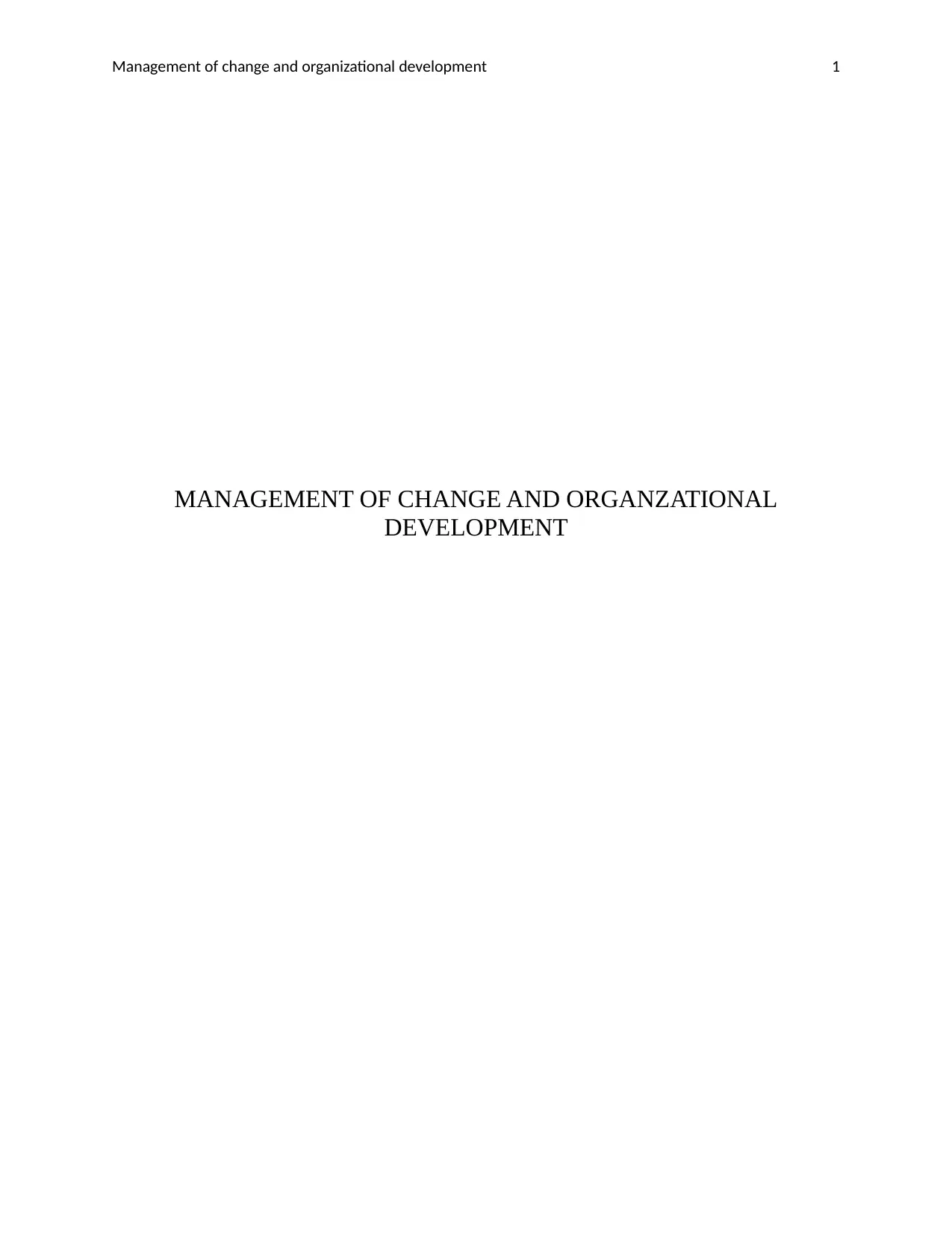
Management of change and organizational development 1
MANAGEMENT OF CHANGE AND ORGANZATIONAL
DEVELOPMENT
MANAGEMENT OF CHANGE AND ORGANZATIONAL
DEVELOPMENT
Paraphrase This Document
Need a fresh take? Get an instant paraphrase of this document with our AI Paraphraser
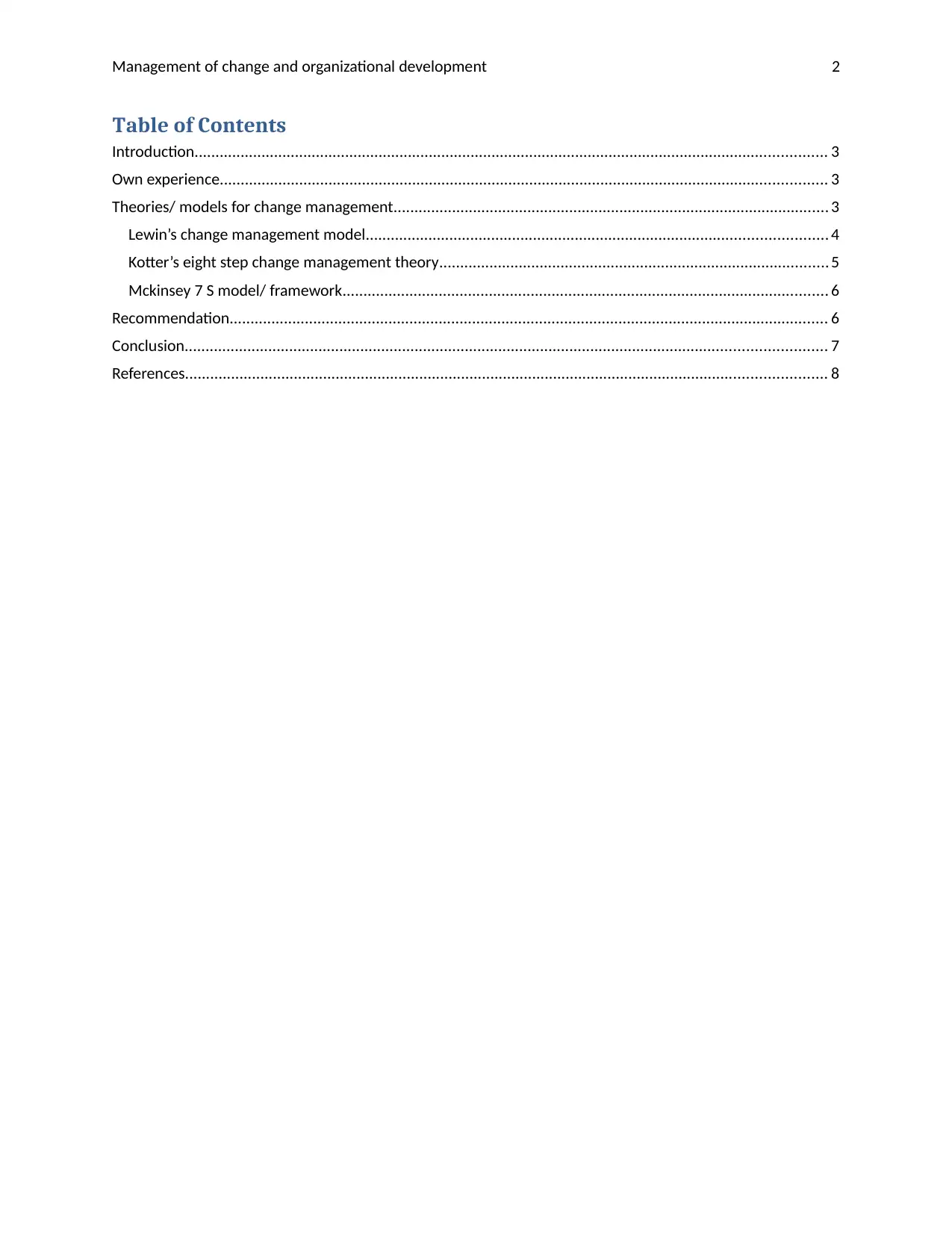
Management of change and organizational development 2
Table of Contents
Introduction....................................................................................................................................................... 3
Own experience................................................................................................................................................. 3
Theories/ models for change management........................................................................................................ 3
Lewin’s change management model.............................................................................................................. 4
Kotter’s eight step change management theory............................................................................................. 5
Mckinsey 7 S model/ framework.................................................................................................................... 6
Recommendation............................................................................................................................................... 6
Conclusion......................................................................................................................................................... 7
References......................................................................................................................................................... 8
Table of Contents
Introduction....................................................................................................................................................... 3
Own experience................................................................................................................................................. 3
Theories/ models for change management........................................................................................................ 3
Lewin’s change management model.............................................................................................................. 4
Kotter’s eight step change management theory............................................................................................. 5
Mckinsey 7 S model/ framework.................................................................................................................... 6
Recommendation............................................................................................................................................... 6
Conclusion......................................................................................................................................................... 7
References......................................................................................................................................................... 8
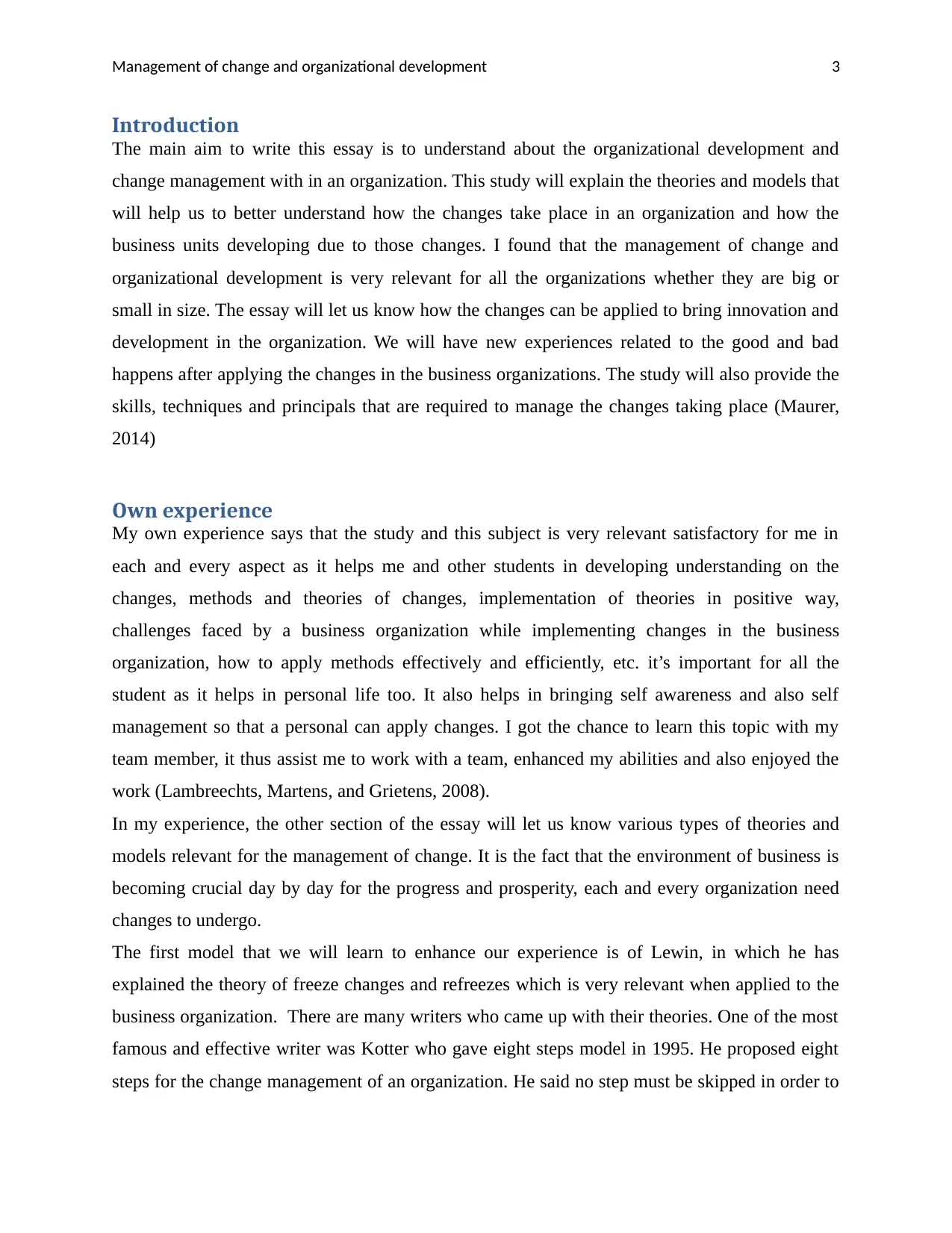
Management of change and organizational development 3
Introduction
The main aim to write this essay is to understand about the organizational development and
change management with in an organization. This study will explain the theories and models that
will help us to better understand how the changes take place in an organization and how the
business units developing due to those changes. I found that the management of change and
organizational development is very relevant for all the organizations whether they are big or
small in size. The essay will let us know how the changes can be applied to bring innovation and
development in the organization. We will have new experiences related to the good and bad
happens after applying the changes in the business organizations. The study will also provide the
skills, techniques and principals that are required to manage the changes taking place (Maurer,
2014)
Own experience
My own experience says that the study and this subject is very relevant satisfactory for me in
each and every aspect as it helps me and other students in developing understanding on the
changes, methods and theories of changes, implementation of theories in positive way,
challenges faced by a business organization while implementing changes in the business
organization, how to apply methods effectively and efficiently, etc. it’s important for all the
student as it helps in personal life too. It also helps in bringing self awareness and also self
management so that a personal can apply changes. I got the chance to learn this topic with my
team member, it thus assist me to work with a team, enhanced my abilities and also enjoyed the
work (Lambreechts, Martens, and Grietens, 2008).
In my experience, the other section of the essay will let us know various types of theories and
models relevant for the management of change. It is the fact that the environment of business is
becoming crucial day by day for the progress and prosperity, each and every organization need
changes to undergo.
The first model that we will learn to enhance our experience is of Lewin, in which he has
explained the theory of freeze changes and refreezes which is very relevant when applied to the
business organization. There are many writers who came up with their theories. One of the most
famous and effective writer was Kotter who gave eight steps model in 1995. He proposed eight
steps for the change management of an organization. He said no step must be skipped in order to
Introduction
The main aim to write this essay is to understand about the organizational development and
change management with in an organization. This study will explain the theories and models that
will help us to better understand how the changes take place in an organization and how the
business units developing due to those changes. I found that the management of change and
organizational development is very relevant for all the organizations whether they are big or
small in size. The essay will let us know how the changes can be applied to bring innovation and
development in the organization. We will have new experiences related to the good and bad
happens after applying the changes in the business organizations. The study will also provide the
skills, techniques and principals that are required to manage the changes taking place (Maurer,
2014)
Own experience
My own experience says that the study and this subject is very relevant satisfactory for me in
each and every aspect as it helps me and other students in developing understanding on the
changes, methods and theories of changes, implementation of theories in positive way,
challenges faced by a business organization while implementing changes in the business
organization, how to apply methods effectively and efficiently, etc. it’s important for all the
student as it helps in personal life too. It also helps in bringing self awareness and also self
management so that a personal can apply changes. I got the chance to learn this topic with my
team member, it thus assist me to work with a team, enhanced my abilities and also enjoyed the
work (Lambreechts, Martens, and Grietens, 2008).
In my experience, the other section of the essay will let us know various types of theories and
models relevant for the management of change. It is the fact that the environment of business is
becoming crucial day by day for the progress and prosperity, each and every organization need
changes to undergo.
The first model that we will learn to enhance our experience is of Lewin, in which he has
explained the theory of freeze changes and refreezes which is very relevant when applied to the
business organization. There are many writers who came up with their theories. One of the most
famous and effective writer was Kotter who gave eight steps model in 1995. He proposed eight
steps for the change management of an organization. He said no step must be skipped in order to
⊘ This is a preview!⊘
Do you want full access?
Subscribe today to unlock all pages.

Trusted by 1+ million students worldwide
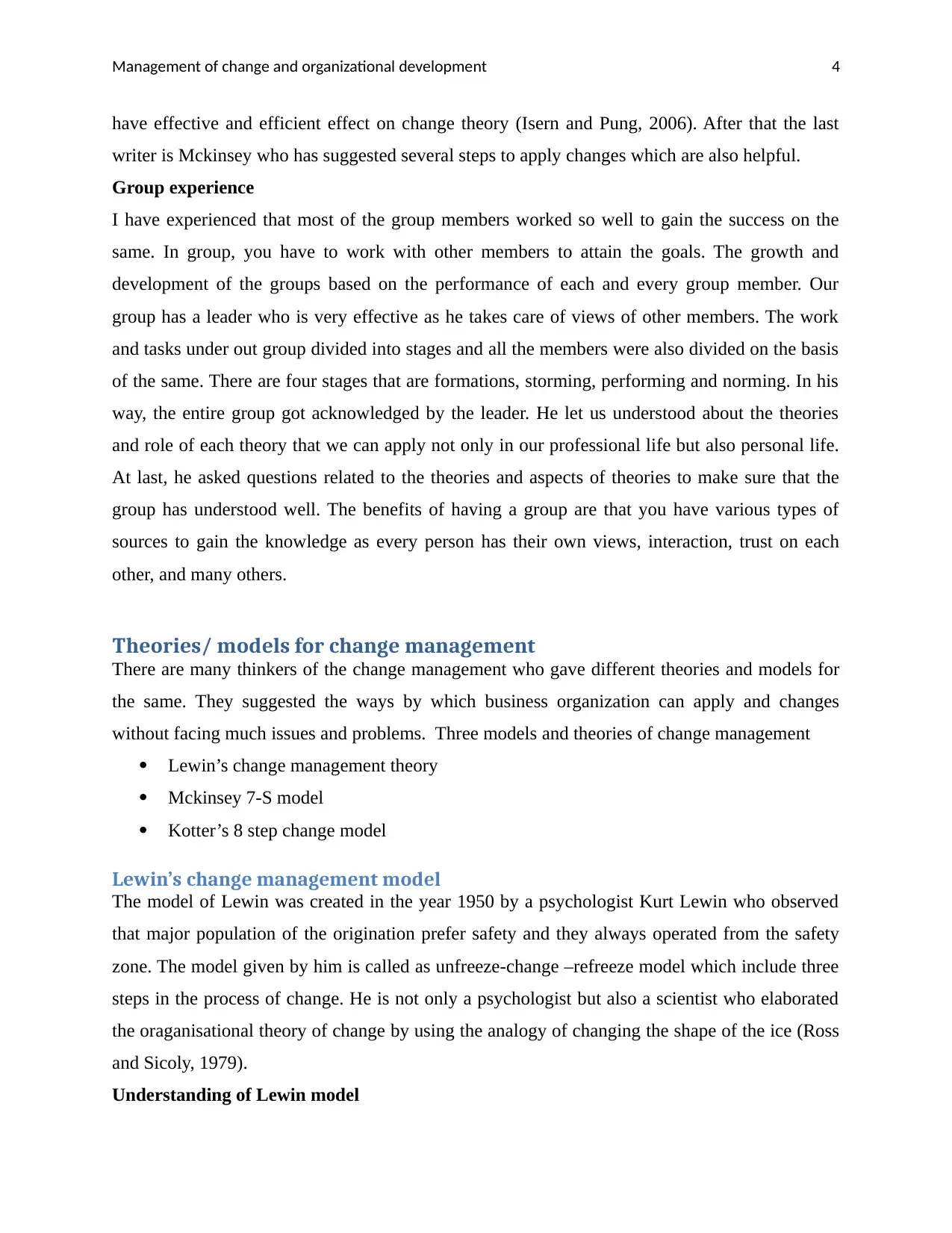
Management of change and organizational development 4
have effective and efficient effect on change theory (Isern and Pung, 2006). After that the last
writer is Mckinsey who has suggested several steps to apply changes which are also helpful.
Group experience
I have experienced that most of the group members worked so well to gain the success on the
same. In group, you have to work with other members to attain the goals. The growth and
development of the groups based on the performance of each and every group member. Our
group has a leader who is very effective as he takes care of views of other members. The work
and tasks under out group divided into stages and all the members were also divided on the basis
of the same. There are four stages that are formations, storming, performing and norming. In his
way, the entire group got acknowledged by the leader. He let us understood about the theories
and role of each theory that we can apply not only in our professional life but also personal life.
At last, he asked questions related to the theories and aspects of theories to make sure that the
group has understood well. The benefits of having a group are that you have various types of
sources to gain the knowledge as every person has their own views, interaction, trust on each
other, and many others.
Theories/ models for change management
There are many thinkers of the change management who gave different theories and models for
the same. They suggested the ways by which business organization can apply and changes
without facing much issues and problems. Three models and theories of change management
Lewin’s change management theory
Mckinsey 7-S model
Kotter’s 8 step change model
Lewin’s change management model
The model of Lewin was created in the year 1950 by a psychologist Kurt Lewin who observed
that major population of the origination prefer safety and they always operated from the safety
zone. The model given by him is called as unfreeze-change –refreeze model which include three
steps in the process of change. He is not only a psychologist but also a scientist who elaborated
the oraganisational theory of change by using the analogy of changing the shape of the ice (Ross
and Sicoly, 1979).
Understanding of Lewin model
have effective and efficient effect on change theory (Isern and Pung, 2006). After that the last
writer is Mckinsey who has suggested several steps to apply changes which are also helpful.
Group experience
I have experienced that most of the group members worked so well to gain the success on the
same. In group, you have to work with other members to attain the goals. The growth and
development of the groups based on the performance of each and every group member. Our
group has a leader who is very effective as he takes care of views of other members. The work
and tasks under out group divided into stages and all the members were also divided on the basis
of the same. There are four stages that are formations, storming, performing and norming. In his
way, the entire group got acknowledged by the leader. He let us understood about the theories
and role of each theory that we can apply not only in our professional life but also personal life.
At last, he asked questions related to the theories and aspects of theories to make sure that the
group has understood well. The benefits of having a group are that you have various types of
sources to gain the knowledge as every person has their own views, interaction, trust on each
other, and many others.
Theories/ models for change management
There are many thinkers of the change management who gave different theories and models for
the same. They suggested the ways by which business organization can apply and changes
without facing much issues and problems. Three models and theories of change management
Lewin’s change management theory
Mckinsey 7-S model
Kotter’s 8 step change model
Lewin’s change management model
The model of Lewin was created in the year 1950 by a psychologist Kurt Lewin who observed
that major population of the origination prefer safety and they always operated from the safety
zone. The model given by him is called as unfreeze-change –refreeze model which include three
steps in the process of change. He is not only a psychologist but also a scientist who elaborated
the oraganisational theory of change by using the analogy of changing the shape of the ice (Ross
and Sicoly, 1979).
Understanding of Lewin model
Paraphrase This Document
Need a fresh take? Get an instant paraphrase of this document with our AI Paraphraser
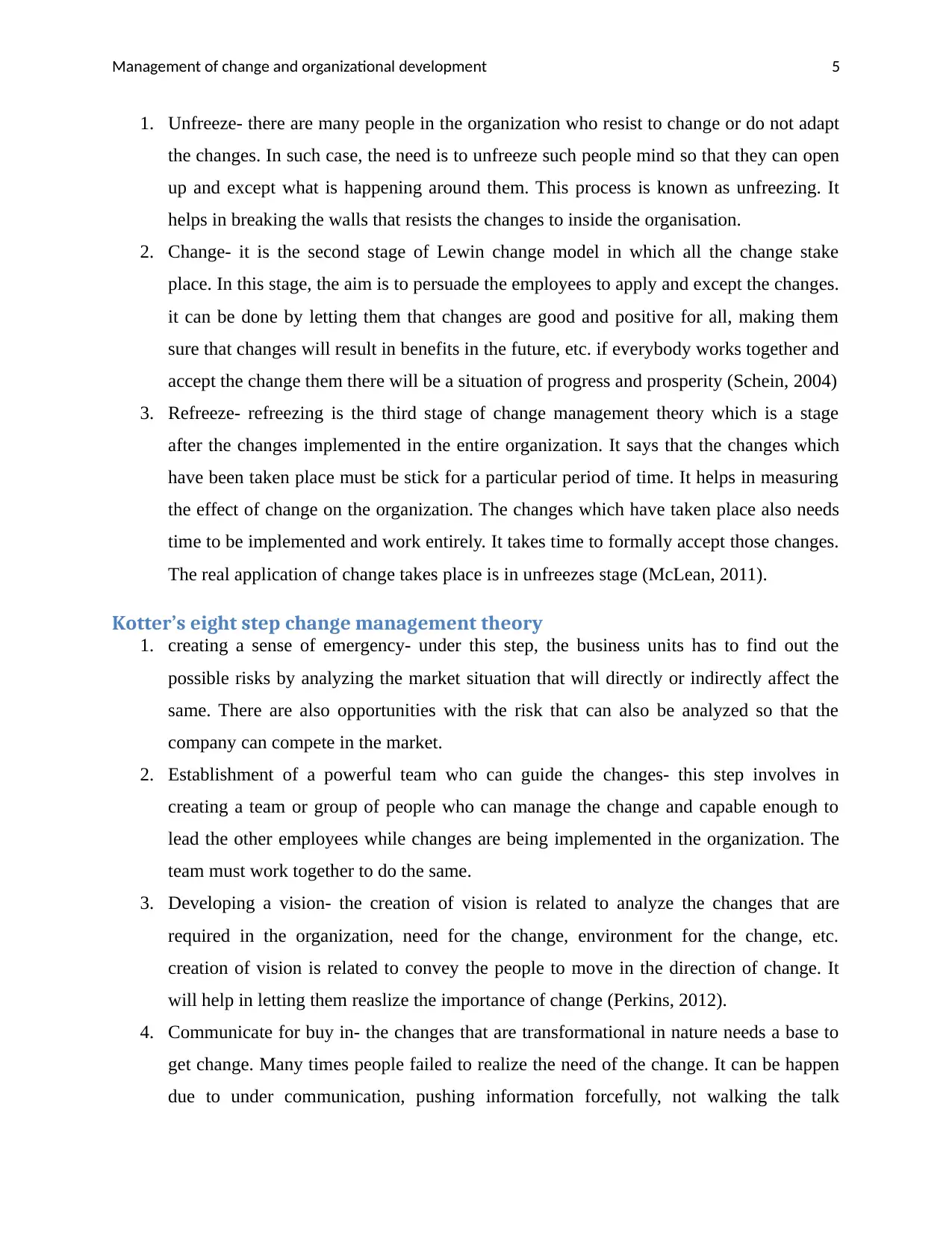
Management of change and organizational development 5
1. Unfreeze- there are many people in the organization who resist to change or do not adapt
the changes. In such case, the need is to unfreeze such people mind so that they can open
up and except what is happening around them. This process is known as unfreezing. It
helps in breaking the walls that resists the changes to inside the organisation.
2. Change- it is the second stage of Lewin change model in which all the change stake
place. In this stage, the aim is to persuade the employees to apply and except the changes.
it can be done by letting them that changes are good and positive for all, making them
sure that changes will result in benefits in the future, etc. if everybody works together and
accept the change them there will be a situation of progress and prosperity (Schein, 2004)
3. Refreeze- refreezing is the third stage of change management theory which is a stage
after the changes implemented in the entire organization. It says that the changes which
have been taken place must be stick for a particular period of time. It helps in measuring
the effect of change on the organization. The changes which have taken place also needs
time to be implemented and work entirely. It takes time to formally accept those changes.
The real application of change takes place is in unfreezes stage (McLean, 2011).
Kotter’s eight step change management theory
1. creating a sense of emergency- under this step, the business units has to find out the
possible risks by analyzing the market situation that will directly or indirectly affect the
same. There are also opportunities with the risk that can also be analyzed so that the
company can compete in the market.
2. Establishment of a powerful team who can guide the changes- this step involves in
creating a team or group of people who can manage the change and capable enough to
lead the other employees while changes are being implemented in the organization. The
team must work together to do the same.
3. Developing a vision- the creation of vision is related to analyze the changes that are
required in the organization, need for the change, environment for the change, etc.
creation of vision is related to convey the people to move in the direction of change. It
will help in letting them reaslize the importance of change (Perkins, 2012).
4. Communicate for buy in- the changes that are transformational in nature needs a base to
get change. Many times people failed to realize the need of the change. It can be happen
due to under communication, pushing information forcefully, not walking the talk
1. Unfreeze- there are many people in the organization who resist to change or do not adapt
the changes. In such case, the need is to unfreeze such people mind so that they can open
up and except what is happening around them. This process is known as unfreezing. It
helps in breaking the walls that resists the changes to inside the organisation.
2. Change- it is the second stage of Lewin change model in which all the change stake
place. In this stage, the aim is to persuade the employees to apply and except the changes.
it can be done by letting them that changes are good and positive for all, making them
sure that changes will result in benefits in the future, etc. if everybody works together and
accept the change them there will be a situation of progress and prosperity (Schein, 2004)
3. Refreeze- refreezing is the third stage of change management theory which is a stage
after the changes implemented in the entire organization. It says that the changes which
have been taken place must be stick for a particular period of time. It helps in measuring
the effect of change on the organization. The changes which have taken place also needs
time to be implemented and work entirely. It takes time to formally accept those changes.
The real application of change takes place is in unfreezes stage (McLean, 2011).
Kotter’s eight step change management theory
1. creating a sense of emergency- under this step, the business units has to find out the
possible risks by analyzing the market situation that will directly or indirectly affect the
same. There are also opportunities with the risk that can also be analyzed so that the
company can compete in the market.
2. Establishment of a powerful team who can guide the changes- this step involves in
creating a team or group of people who can manage the change and capable enough to
lead the other employees while changes are being implemented in the organization. The
team must work together to do the same.
3. Developing a vision- the creation of vision is related to analyze the changes that are
required in the organization, need for the change, environment for the change, etc.
creation of vision is related to convey the people to move in the direction of change. It
will help in letting them reaslize the importance of change (Perkins, 2012).
4. Communicate for buy in- the changes that are transformational in nature needs a base to
get change. Many times people failed to realize the need of the change. It can be happen
due to under communication, pushing information forcefully, not walking the talk
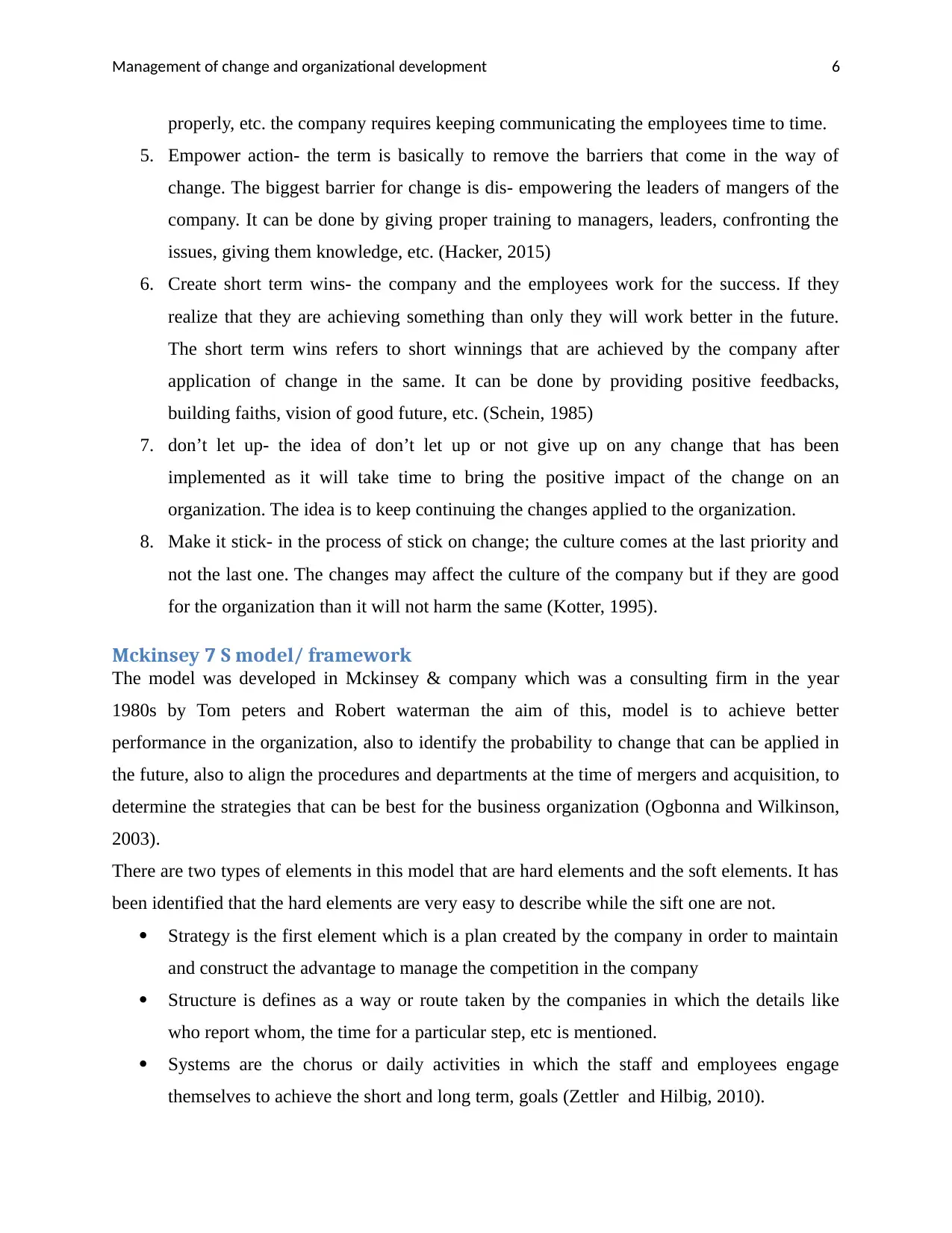
Management of change and organizational development 6
properly, etc. the company requires keeping communicating the employees time to time.
5. Empower action- the term is basically to remove the barriers that come in the way of
change. The biggest barrier for change is dis- empowering the leaders of mangers of the
company. It can be done by giving proper training to managers, leaders, confronting the
issues, giving them knowledge, etc. (Hacker, 2015)
6. Create short term wins- the company and the employees work for the success. If they
realize that they are achieving something than only they will work better in the future.
The short term wins refers to short winnings that are achieved by the company after
application of change in the same. It can be done by providing positive feedbacks,
building faiths, vision of good future, etc. (Schein, 1985)
7. don’t let up- the idea of don’t let up or not give up on any change that has been
implemented as it will take time to bring the positive impact of the change on an
organization. The idea is to keep continuing the changes applied to the organization.
8. Make it stick- in the process of stick on change; the culture comes at the last priority and
not the last one. The changes may affect the culture of the company but if they are good
for the organization than it will not harm the same (Kotter, 1995).
Mckinsey 7 S model/ framework
The model was developed in Mckinsey & company which was a consulting firm in the year
1980s by Tom peters and Robert waterman the aim of this, model is to achieve better
performance in the organization, also to identify the probability to change that can be applied in
the future, also to align the procedures and departments at the time of mergers and acquisition, to
determine the strategies that can be best for the business organization (Ogbonna and Wilkinson,
2003).
There are two types of elements in this model that are hard elements and the soft elements. It has
been identified that the hard elements are very easy to describe while the sift one are not.
Strategy is the first element which is a plan created by the company in order to maintain
and construct the advantage to manage the competition in the company
Structure is defines as a way or route taken by the companies in which the details like
who report whom, the time for a particular step, etc is mentioned.
Systems are the chorus or daily activities in which the staff and employees engage
themselves to achieve the short and long term, goals (Zettler and Hilbig, 2010).
properly, etc. the company requires keeping communicating the employees time to time.
5. Empower action- the term is basically to remove the barriers that come in the way of
change. The biggest barrier for change is dis- empowering the leaders of mangers of the
company. It can be done by giving proper training to managers, leaders, confronting the
issues, giving them knowledge, etc. (Hacker, 2015)
6. Create short term wins- the company and the employees work for the success. If they
realize that they are achieving something than only they will work better in the future.
The short term wins refers to short winnings that are achieved by the company after
application of change in the same. It can be done by providing positive feedbacks,
building faiths, vision of good future, etc. (Schein, 1985)
7. don’t let up- the idea of don’t let up or not give up on any change that has been
implemented as it will take time to bring the positive impact of the change on an
organization. The idea is to keep continuing the changes applied to the organization.
8. Make it stick- in the process of stick on change; the culture comes at the last priority and
not the last one. The changes may affect the culture of the company but if they are good
for the organization than it will not harm the same (Kotter, 1995).
Mckinsey 7 S model/ framework
The model was developed in Mckinsey & company which was a consulting firm in the year
1980s by Tom peters and Robert waterman the aim of this, model is to achieve better
performance in the organization, also to identify the probability to change that can be applied in
the future, also to align the procedures and departments at the time of mergers and acquisition, to
determine the strategies that can be best for the business organization (Ogbonna and Wilkinson,
2003).
There are two types of elements in this model that are hard elements and the soft elements. It has
been identified that the hard elements are very easy to describe while the sift one are not.
Strategy is the first element which is a plan created by the company in order to maintain
and construct the advantage to manage the competition in the company
Structure is defines as a way or route taken by the companies in which the details like
who report whom, the time for a particular step, etc is mentioned.
Systems are the chorus or daily activities in which the staff and employees engage
themselves to achieve the short and long term, goals (Zettler and Hilbig, 2010).
⊘ This is a preview!⊘
Do you want full access?
Subscribe today to unlock all pages.

Trusted by 1+ million students worldwide
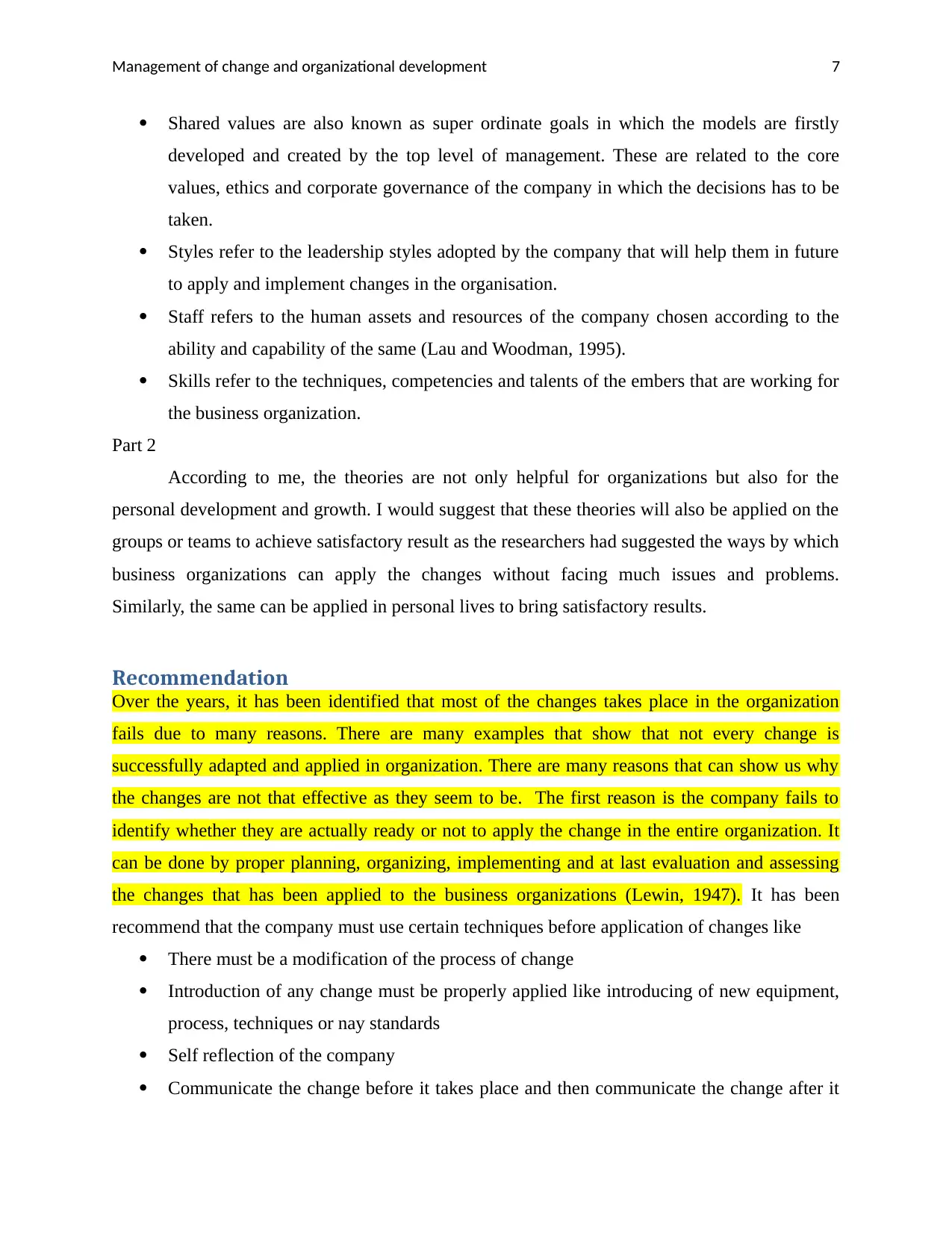
Management of change and organizational development 7
Shared values are also known as super ordinate goals in which the models are firstly
developed and created by the top level of management. These are related to the core
values, ethics and corporate governance of the company in which the decisions has to be
taken.
Styles refer to the leadership styles adopted by the company that will help them in future
to apply and implement changes in the organisation.
Staff refers to the human assets and resources of the company chosen according to the
ability and capability of the same (Lau and Woodman, 1995).
Skills refer to the techniques, competencies and talents of the embers that are working for
the business organization.
Part 2
According to me, the theories are not only helpful for organizations but also for the
personal development and growth. I would suggest that these theories will also be applied on the
groups or teams to achieve satisfactory result as the researchers had suggested the ways by which
business organizations can apply the changes without facing much issues and problems.
Similarly, the same can be applied in personal lives to bring satisfactory results.
Recommendation
Over the years, it has been identified that most of the changes takes place in the organization
fails due to many reasons. There are many examples that show that not every change is
successfully adapted and applied in organization. There are many reasons that can show us why
the changes are not that effective as they seem to be. The first reason is the company fails to
identify whether they are actually ready or not to apply the change in the entire organization. It
can be done by proper planning, organizing, implementing and at last evaluation and assessing
the changes that has been applied to the business organizations (Lewin, 1947). It has been
recommend that the company must use certain techniques before application of changes like
There must be a modification of the process of change
Introduction of any change must be properly applied like introducing of new equipment,
process, techniques or nay standards
Self reflection of the company
Communicate the change before it takes place and then communicate the change after it
Shared values are also known as super ordinate goals in which the models are firstly
developed and created by the top level of management. These are related to the core
values, ethics and corporate governance of the company in which the decisions has to be
taken.
Styles refer to the leadership styles adopted by the company that will help them in future
to apply and implement changes in the organisation.
Staff refers to the human assets and resources of the company chosen according to the
ability and capability of the same (Lau and Woodman, 1995).
Skills refer to the techniques, competencies and talents of the embers that are working for
the business organization.
Part 2
According to me, the theories are not only helpful for organizations but also for the
personal development and growth. I would suggest that these theories will also be applied on the
groups or teams to achieve satisfactory result as the researchers had suggested the ways by which
business organizations can apply the changes without facing much issues and problems.
Similarly, the same can be applied in personal lives to bring satisfactory results.
Recommendation
Over the years, it has been identified that most of the changes takes place in the organization
fails due to many reasons. There are many examples that show that not every change is
successfully adapted and applied in organization. There are many reasons that can show us why
the changes are not that effective as they seem to be. The first reason is the company fails to
identify whether they are actually ready or not to apply the change in the entire organization. It
can be done by proper planning, organizing, implementing and at last evaluation and assessing
the changes that has been applied to the business organizations (Lewin, 1947). It has been
recommend that the company must use certain techniques before application of changes like
There must be a modification of the process of change
Introduction of any change must be properly applied like introducing of new equipment,
process, techniques or nay standards
Self reflection of the company
Communicate the change before it takes place and then communicate the change after it
Paraphrase This Document
Need a fresh take? Get an instant paraphrase of this document with our AI Paraphraser
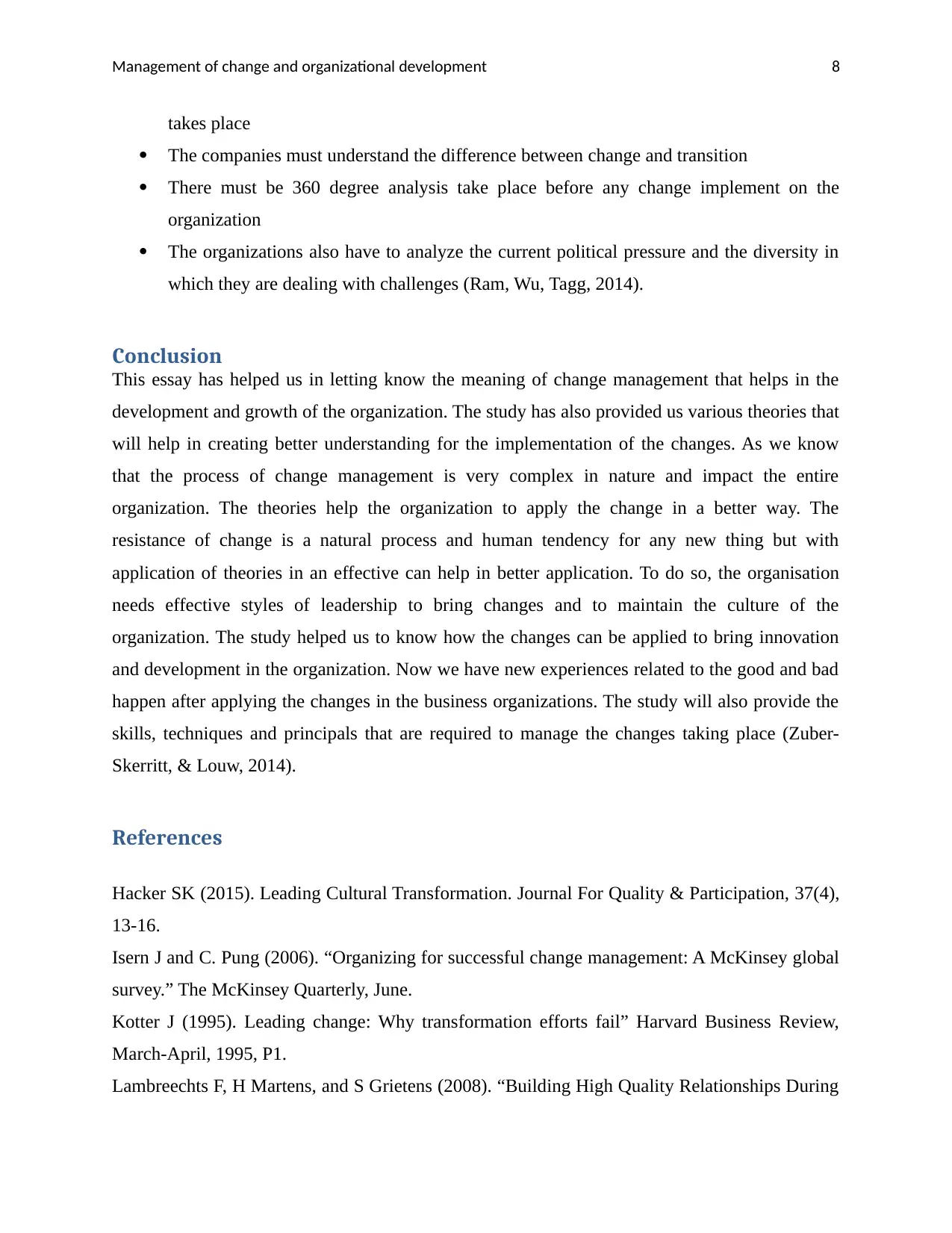
Management of change and organizational development 8
takes place
The companies must understand the difference between change and transition
There must be 360 degree analysis take place before any change implement on the
organization
The organizations also have to analyze the current political pressure and the diversity in
which they are dealing with challenges (Ram, Wu, Tagg, 2014).
Conclusion
This essay has helped us in letting know the meaning of change management that helps in the
development and growth of the organization. The study has also provided us various theories that
will help in creating better understanding for the implementation of the changes. As we know
that the process of change management is very complex in nature and impact the entire
organization. The theories help the organization to apply the change in a better way. The
resistance of change is a natural process and human tendency for any new thing but with
application of theories in an effective can help in better application. To do so, the organisation
needs effective styles of leadership to bring changes and to maintain the culture of the
organization. The study helped us to know how the changes can be applied to bring innovation
and development in the organization. Now we have new experiences related to the good and bad
happen after applying the changes in the business organizations. The study will also provide the
skills, techniques and principals that are required to manage the changes taking place (Zuber-
Skerritt, & Louw, 2014).
References
Hacker SK (2015). Leading Cultural Transformation. Journal For Quality & Participation, 37(4),
13-16.
Isern J and C. Pung (2006). “Organizing for successful change management: A McKinsey global
survey.” The McKinsey Quarterly, June.
Kotter J (1995). Leading change: Why transformation efforts fail” Harvard Business Review,
March-April, 1995, P1.
Lambreechts F, H Martens, and S Grietens (2008). “Building High Quality Relationships During
takes place
The companies must understand the difference between change and transition
There must be 360 degree analysis take place before any change implement on the
organization
The organizations also have to analyze the current political pressure and the diversity in
which they are dealing with challenges (Ram, Wu, Tagg, 2014).
Conclusion
This essay has helped us in letting know the meaning of change management that helps in the
development and growth of the organization. The study has also provided us various theories that
will help in creating better understanding for the implementation of the changes. As we know
that the process of change management is very complex in nature and impact the entire
organization. The theories help the organization to apply the change in a better way. The
resistance of change is a natural process and human tendency for any new thing but with
application of theories in an effective can help in better application. To do so, the organisation
needs effective styles of leadership to bring changes and to maintain the culture of the
organization. The study helped us to know how the changes can be applied to bring innovation
and development in the organization. Now we have new experiences related to the good and bad
happen after applying the changes in the business organizations. The study will also provide the
skills, techniques and principals that are required to manage the changes taking place (Zuber-
Skerritt, & Louw, 2014).
References
Hacker SK (2015). Leading Cultural Transformation. Journal For Quality & Participation, 37(4),
13-16.
Isern J and C. Pung (2006). “Organizing for successful change management: A McKinsey global
survey.” The McKinsey Quarterly, June.
Kotter J (1995). Leading change: Why transformation efforts fail” Harvard Business Review,
March-April, 1995, P1.
Lambreechts F, H Martens, and S Grietens (2008). “Building High Quality Relationships During
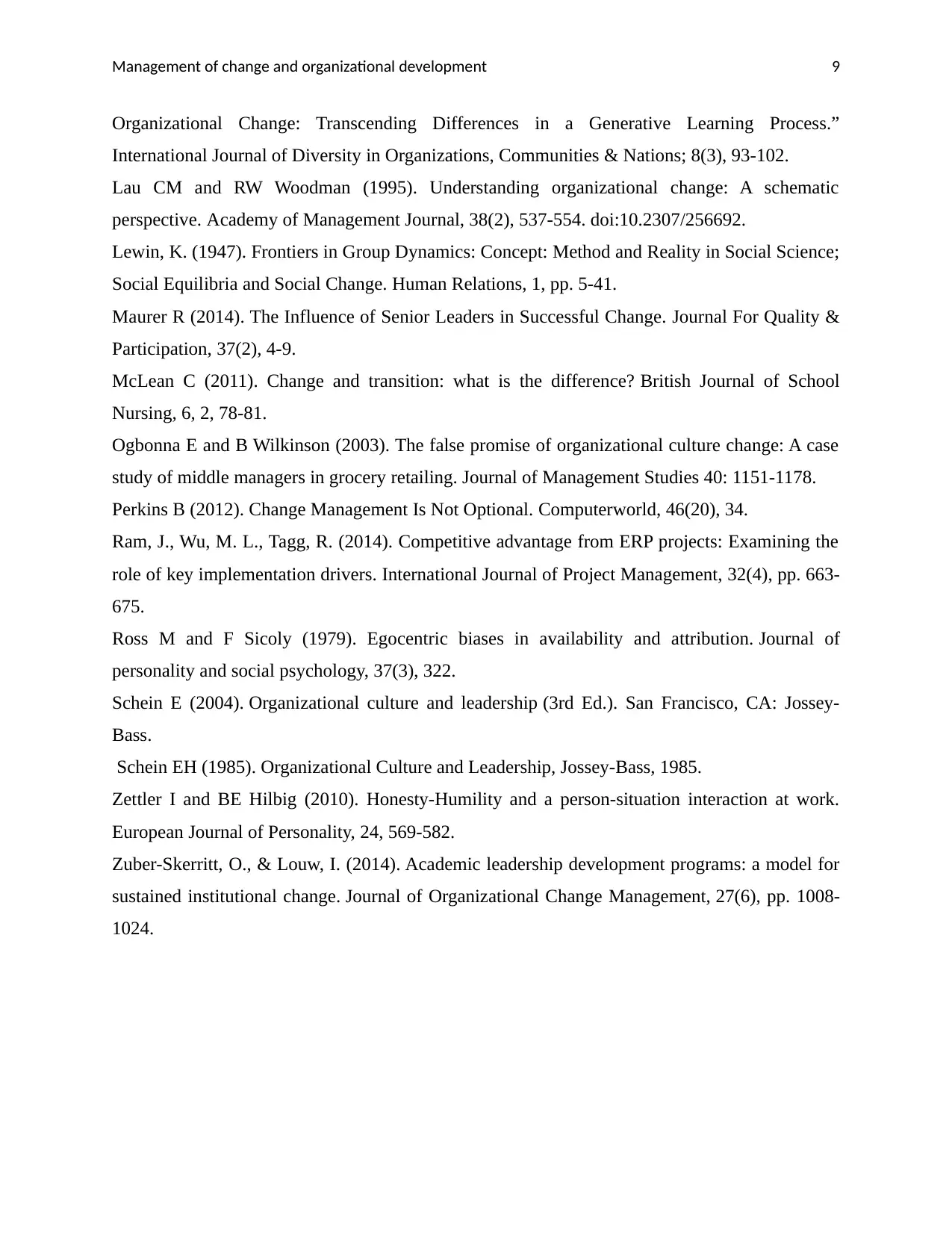
Management of change and organizational development 9
Organizational Change: Transcending Differences in a Generative Learning Process.”
International Journal of Diversity in Organizations, Communities & Nations; 8(3), 93-102.
Lau CM and RW Woodman (1995). Understanding organizational change: A schematic
perspective. Academy of Management Journal, 38(2), 537-554. doi:10.2307/256692.
Lewin, K. (1947). Frontiers in Group Dynamics: Concept: Method and Reality in Social Science;
Social Equilibria and Social Change. Human Relations, 1, pp. 5-41.
Maurer R (2014). The Influence of Senior Leaders in Successful Change. Journal For Quality &
Participation, 37(2), 4-9.
McLean C (2011). Change and transition: what is the difference? British Journal of School
Nursing, 6, 2, 78-81.
Ogbonna E and B Wilkinson (2003). The false promise of organizational culture change: A case
study of middle managers in grocery retailing. Journal of Management Studies 40: 1151-1178.
Perkins B (2012). Change Management Is Not Optional. Computerworld, 46(20), 34.
Ram, J., Wu, M. L., Tagg, R. (2014). Competitive advantage from ERP projects: Examining the
role of key implementation drivers. International Journal of Project Management, 32(4), pp. 663-
675.
Ross M and F Sicoly (1979). Egocentric biases in availability and attribution. Journal of
personality and social psychology, 37(3), 322.
Schein E (2004). Organizational culture and leadership (3rd Ed.). San Francisco, CA: Jossey-
Bass.
Schein EH (1985). Organizational Culture and Leadership, Jossey-Bass, 1985.
Zettler I and BE Hilbig (2010). Honesty-Humility and a person-situation interaction at work.
European Journal of Personality, 24, 569-582.
Zuber-Skerritt, O., & Louw, I. (2014). Academic leadership development programs: a model for
sustained institutional change. Journal of Organizational Change Management, 27(6), pp. 1008-
1024.
Organizational Change: Transcending Differences in a Generative Learning Process.”
International Journal of Diversity in Organizations, Communities & Nations; 8(3), 93-102.
Lau CM and RW Woodman (1995). Understanding organizational change: A schematic
perspective. Academy of Management Journal, 38(2), 537-554. doi:10.2307/256692.
Lewin, K. (1947). Frontiers in Group Dynamics: Concept: Method and Reality in Social Science;
Social Equilibria and Social Change. Human Relations, 1, pp. 5-41.
Maurer R (2014). The Influence of Senior Leaders in Successful Change. Journal For Quality &
Participation, 37(2), 4-9.
McLean C (2011). Change and transition: what is the difference? British Journal of School
Nursing, 6, 2, 78-81.
Ogbonna E and B Wilkinson (2003). The false promise of organizational culture change: A case
study of middle managers in grocery retailing. Journal of Management Studies 40: 1151-1178.
Perkins B (2012). Change Management Is Not Optional. Computerworld, 46(20), 34.
Ram, J., Wu, M. L., Tagg, R. (2014). Competitive advantage from ERP projects: Examining the
role of key implementation drivers. International Journal of Project Management, 32(4), pp. 663-
675.
Ross M and F Sicoly (1979). Egocentric biases in availability and attribution. Journal of
personality and social psychology, 37(3), 322.
Schein E (2004). Organizational culture and leadership (3rd Ed.). San Francisco, CA: Jossey-
Bass.
Schein EH (1985). Organizational Culture and Leadership, Jossey-Bass, 1985.
Zettler I and BE Hilbig (2010). Honesty-Humility and a person-situation interaction at work.
European Journal of Personality, 24, 569-582.
Zuber-Skerritt, O., & Louw, I. (2014). Academic leadership development programs: a model for
sustained institutional change. Journal of Organizational Change Management, 27(6), pp. 1008-
1024.
⊘ This is a preview!⊘
Do you want full access?
Subscribe today to unlock all pages.

Trusted by 1+ million students worldwide
1 out of 9
Related Documents
Your All-in-One AI-Powered Toolkit for Academic Success.
+13062052269
info@desklib.com
Available 24*7 on WhatsApp / Email
![[object Object]](/_next/static/media/star-bottom.7253800d.svg)
Unlock your academic potential
Copyright © 2020–2025 A2Z Services. All Rights Reserved. Developed and managed by ZUCOL.




